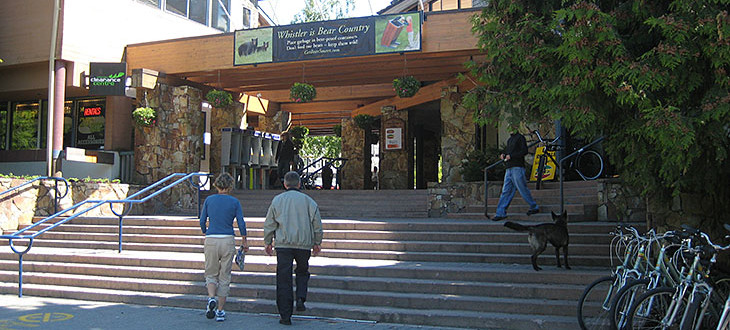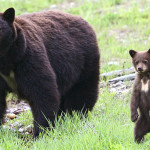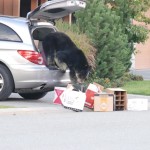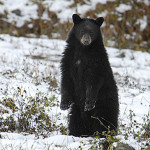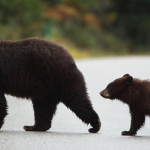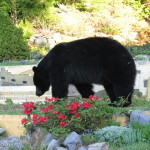Building a Bear Smart Community
Everything you always wanted to know…….
Recently, the Grizzly Bear Outreach Project (GBOP) team skyped Get Bear Smart to learn more about creating bear smart communities in Washington. I’m sure many of you have the same questions, so I thought I’d provide a summary of the conversation.
Can you give us an overview of the Bear Smart approach you have adopted in Whistler, and why you take that approach?
In short, I would say that we tried to follow the six steps for becoming a bear smart community as laid out by the BC Ministry of Environment. Keep in mind however, that we were one of the first communities to start this process, so we didn’t exactly follow the program, step by step in the order that it is now laid out, but we did eventually complete all of the steps. If a community is unable to complete the full program and start at the beginning, I would have to say that the most critical piece is bear-proofing the waste management system. I think that this one initiative will have the greatest impact on reducing conflict and saving bear’s lives.
Additionally, I think it’s important to work with your wildlife agency to resolve conflicts non-lethally whenever possible. Buy-in from those that manage wildlife is crucial. The manner in which they mitigate conflicts will have a trickle down influence on people’s attitudes. If, for example, wildlife managers and police kill bears to protect people’s safety, then people will perceive bears as being more dangerous than they really are, but it will also take the onus off of individuals to remove the source of the problem – it won’t be necessary to bear-proof their trash, because officials are willing to come and remove the bear and the perceived problem. However, it’s a short-sighted and temporary fix. Another bear will come along and take over the vacated habitat niche, especially if the attractants remain. As always, the only long-term solution is to remove the source of the problem i.e. the attractants.
There is of course tons of information on our website addressing that question including links and downloads to other relevant materials. I would encourage you to explore the site and learn more, particularly the section on creating bear smart communities.
When designing your bear smart education program, have you focused on changing societal norms such as how people negatively perceive bears, or do you focus on public safety and the benefits residents receive if they properly manage attractants?
Both are important. Changing societal norms should be an underlying theme in all of your education. It may not be something that you deal with directly, but it’s important to always give consideration to creating a paradigm shift in people’s attitudes toward bears and other wildlife by replacing fear and ignorance with understanding and respect.
In terms of…… focusing on the benefits residents receive if they properly manage attractants – it is important to first determine what residents think those are. Don’t assume you know what they’re thinking – you absolutely don’t. An independent professional should conduct a proper evaluation by running focus groups and asking what the benefits and barriers to various bear smart behaviours are. You should run a minimum of two separate groups – one that is bear smart and another that is not. There are lots of other things to take into account when running an effective focus group. Review Whistler’s Focus Group Report.
Bear Hazard Assessment: What are the key elements most important to assess?
As noted on our website, the first step is to figure out exactly what (and where) the problems are.
Conducting a preliminary bear hazard assessment will provide a general but community-specific overview of human-bear conflicts in and adjacent to the community. A comprehensive preliminary bear hazard assessment should:
1. Identify sites, areas, trails, and practices that have historic, existing and potential levels of human-bear conflict.
2. Identify gaps in the existing knowledge of bear use and human-bear conflict in the area and provide recommendations for further investigation and additional hazard assessment phases.
3. Develop management recommendations to reduce existing and potential conflict within the community.
We are trying to follow the principles of Community-Based Social Marketing to foster sustainable behaviour change in people. How do we determine what behavior we want to encourage or discourage?
GBS evaluated the three behaviours that contributed to the most conflicts e.g. handling garbage, feeding birds and leaving widows/doors open (allowing bears to easily enter homes).
What information helped you determine this? Data from the Conservation Officer Service Occurrence Reports detailing the cause of the conflict.
How do we best determine which audience we want to reach? Look at your conflict data and see where incidents are occurring, then you can target specific neighbourhoods; or the data may lead you to discover that a certain demographic is responsible for most conflict. In Whistler, we were surprised to learn that it is not the visitors and transient workers who are involved in most conflicts, but the long-time local residents. This allowed us to target our education more specifically to that segment.
Can you tell us about your school programs? Have they been effective?
I think school programs are a must. In Whistler, every kid who goes through the school system is educated about bears. First and foremost, children who live in bear country need to know what to do when they encounter a bear in their yard or on the way to school. Secondly, it’s important that they learn the truth at an early age and don’t base their understanding on rumor, myths and fairy tales. Lastly, kids make great teachers themselves. They not only go home and tell their parents what they’ve learned, but they will often police their parent’s behaviour e.g. they’ll let them know that it’s not appropriate to leave the recycling outside.
What educational tools have you found most effective? Presentations, one-on-ones, social gatherings?
Presentations can be effective if you have an engaging speaker that is knowledgeable about the subject. Social media tools like Facebook are becoming more and more popular. Online media may be taking over traditional printed brochures as a source for information e.g. YouTube instructional/educational videos, pod casts, Facebook, Twitter.
How do you get broad stakeholder involvement?
Fortunately for us, that’s something that we’ve found pretty easy. We simply invited them to the table. We have monthly meetings involving all of our stakeholders – anyone who has a responsibility for or is affected by human-bear conflicts – from the local waste-hauler and major business in town to the municipal government officials and wildlife agency personnel. Once you have them at the table, it’s really important to listen to what they have to say. If they’re not being heard, they’ll stop participating. There will be many differences of opinion at the table, but you’ll find that most of you agree on 90% of the solutions. Try not to get bogged down with each stakeholder’s motivation for moving forward – it’s not important – what is important is working together on the solution. Taking that thought one step further…. I think it’s actually critical to determine what each stakeholder’s motivation is so that you can find a way to address their concerns whenever possible. For example, the waste-hauler may have concerns about the additional costs of bear-proof waste containment over regular models. This is a valid concern. They are a for-profit business. You will need to find a way to help them lessen the burden. One solution might be for the NGO at the table to pursue a grant to help with costs.
Learn more about Whistler’s Bear Working Group.
How do you engage the public?
Unfortunately, people are the most interested in getting involved after a significant number of bears have been killed. Interest wanes as the number of conflicts and bear mortality decreases. Again, you’ll need to determine what people’s concerns are and base your campaigns on finding cost effective solutions that address their concerns and consider the welfare and lives of bears.
What have been your most successful efforts in this regard?
Keeping the issue alive in the hearts and minds of community members is key. They must “own” the problem and the solution. As Dr. Phil would say, “you can’t change what you don’t acknowledge”. Residents have to realize that they are part of the problem and the onus is on them to find solutions. It’s not up to the wildlife agency to come and take away their problem i.e. relocate or kill the bear.
It’s also important to engage their interest with great human interest stories in the media. Here in Whistler, for example, we name our bears and residents follow individual bear’s life histories in the newspaper. Almost anyone in town can recount a story about an individual bear that they know by name. It’s much easier for people to feel compassion and empathy for an individual bear that has a real life story (e.g. a mother that has cubs to take care of who is being challenged by another dominant female or a male that may be trying to kill her cubs) than the species in general – it’s just not personal enough. Perhaps you’d like to meet some of Whistler’s bears in the book A Whistler Bear Story.
And, yes, I understand that wildlife agency staff are often opposed to anthropomorphizing animals. They get a lot of grief when a named bear gets shot. That’s not a bad thing – that’s a good thing. That means that people care and that’s what creates the motivation and impetus for positive change. Nothing has ever changed as a result of things running smoothly.
I would also like to add that enforcement is important. There will always be a small segment of the community that is unwilling to bear-proof their garbage or remove attractants. For that segment, it’s important to have provincial/state legislation or municipal bylaws and ordinances that will force them to behave in a bear smart manner.
How do you involve volunteers in your Bear Smart programs?
To be very honest, GBS has found it very challenging to engage large numbers of volunteers. We are a very transient community. Yes, we do have a stable long term residency base, but for the most part these folks don’t see themselves as part of the problem – they like the bears and don’t mind having them around. Unfortunately, we often invest more time training volunteers than the time returned in volunteer efforts. That said, I don’t want to discourage anyone from working with volunteers. It’s just not been that successful for us. There are many organizations that have successful volunteer programs.
Do they have to go through a rigorous training? Because our volunteer program is so small, we don’t have a rigorous training program. We train each person individually depending on the job they are taking on.
What types of things do the volunteers undertake? Most volunteers have a fantasy image of volunteering their time to undertake exciting research in the field and with bears. Unfortunately, we don’t have those kinds of opportunities. Our long term, reliable volunteers help with collection of coin box revenues, delivery of brochures and help with special events and educational booths.
We discussed bringing together groups and agencies working on bear outreach and education to share success stories and look for ways to collaborate. Do you think this would be useful?
Absolutely, it is critical to collaborate on projects, if for no other reason but to eliminate redundancy and ensure a consistent message is being delivered. It would be a good idea to come up with agreed upon messaging (responses to generally asked questions), so that you are all on the same page.
Have you tried the bear-resistant bird feeders? Do they work?
Yes and yes, so long as the seeds below the feeder are removed very regularly. Here’s some info. about bear-proofing your bird feeder.
What other products do you promote to the public? I like the scarecrow – a device that is hooked up to a normal garden hose and mounted in the ground. When the motion detector senses movement, the Scarecrow sprays a 3 to 4 second burst of water at the intruder. Click here for a full list of deterrents. We of course promote bear-proof waste containment and electric fencing as well. There’s nothing more secure than a well maintained electric fence and it’s relatively inexpensive and easy to set up.

